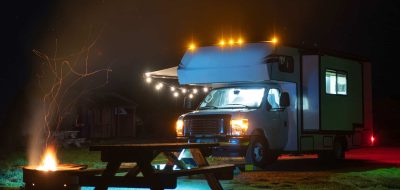Gear to Get with Brian Brawdy
One of the necessities of Green RVing, boondocking & dry camping is the ability to generate power. By tapping into the free and ubiquitous energies of the sun, I’m able to go off road, off the grid while staying out longer.
In this video, I look at the cutting edge technology of the PowerSource 1800. A uniquely designed solar powered generator.
[youtube 1QfjfjUTKbQ]
For more information on Brian Brawdy or Greening your RV, please visit BrianBrawdy.com








Pingback: my url
Tom janssen
Hi I love the equipment but do have some problems.
I am living in the slowak republic and bought land in middle of nowhere,
this is 12V AC output right, I would need 220VDC to operate equipment here.
I am really interested. I would need it during short interfalls f.i. running a waterpomp or running a householde drill. For that high powered usuage i would use only short periods of tim, only waterpumps and relatively low capacity appliances.
Could that be possible to obtain such (converter) to 220 as well?
I would really appreaciate any help in this. From China industry only seems interested in selling 100 pieces at the time. Cannot get through there…
Here in europe this kind i cannot find (yet) would be pleased to promote for you at outdoor sustaining life becomes more pop over here..
Or some agents here in germany, austria of anywhere..would help me a lot. I need to select a powersupply source soon and so not want to be forced to fall back on the good ol fossile fuel generator..
Kind regards from a dutchman who bought land in the slowak republic…no grid there..Thanks in advance for any tip!!
Glenn Dixon
More solar info than you can handle, from a guy who full-time boondocks with no generator:
http://handybobsolar.com
Mark
Brian
What I objected to is that the 1800 is nothing but a small portable solar system.
Using the term “Generator” is immediately misleading. It makes it sound like it will produce a rated amount of energy as long as the tiny panel is sitting in the sun. Like a real generator would only no engine and fuel. This thing has a very small reserve that once gone takes some time to recover (read NO power) using the one little solar panel. I really take a dislike to “Experts” pushing over priced and misleading stuff on RVers who may not know any better.
Chad Tudor
1,600 for a solar panel, controler, 50 foot of wire, mounting brakets, modifications to make it ‘plug n play’, and the powersource 1800? 1,600 USD, correct?
That solar panel can found for like 300.00
powersource1800 on ebay for 240-500.00
wire, male/female adapters, junction box, etc should be no more than 150.00
So they want 1,600.00 for something that costs 950.00 to construct? Their charging 500.00 (+/-) for labor!
Buy the parts individually, maybe even get a larger 120watt panel, hire a electrician for a case of beer and 100.00 and you save hundreds of dollars!
Fred
Brian
I am a fully dedicated solar energy user. I do have a generator, but I haven’t have to run it for charging purposes. I only use it while boondocking and it gets a bit too warm inside the camper.
My solar charging system consists of:
Four 130 watt panels – two mounted on a swiveling, tiltable frame on the roof and two portable on the ground with 50′ each of negative and postive cables. Max capacity 520 watts.
Six deepcycle batteries for 450 AH at 12 volts.
One 2000 watt true sine-wave inverter and the controllers and monitors.
I rarely deplete the battries in one night below 60% full charge. They usually charge to full by the end of next day if it is sunny.
My two greatest pleasures with this system are it’s independence and it is so easy on the ears.
Keep up the good articles!
Fred
Brian Brawdy
Hey Guys.
In that I use this as an Emergency Backup Power Supply for the most part and daily use it for my computers, iPhones, my still and video cameras, it works great for me as a modified sine wave. I’m told that 98% of all electrical appliances can do so. The solar panel is 90 watts, it cuts off at 10.5 volts so I don’t drain it all the way, and it has been my experience (over the last four weeks) that it takes me three hours in direct sunlight to get it back to 13 volts (full charge).
Your weight calculations are spot on, 56 lbs hasn’t been hard for me (even though a lightfoot) to lift or store for travel, but that’s me. If you dig a gas generator, I say use a gas generator!
Billy Mays? Not the first time I’ve heard that; candidly I don’t mind the reference.
In that I am not an electrical engineer, my expertise is almost expired here, so I wanted to hook you up with one. Please contact David (electrical eng) at [email protected].
As always, thanks for your suggestions and critiques. Please keep them coming.
Brian Brawdy
Fred
I’m a die-hard fan of Bob Difley and he often refers me to your blog. This power supply setup would be ample for a couple of hours at best. I did some research and found these specs of the Duracell 1800:
Three sealed lead acid batteries capacity @ 17AH each = 51 AH; if the power needed at night with cool temperatures (furnace use) and other normally used devices (lights – computer – Sattelite TV – 10 minutes use of microwave), the power usage overnight may be something close to 400 watts. That converts to 33 AH at 12 volts and would be about 1.5 hours usage until the batteries run too low and does agree with the stated run time below.
Stated run time is “up to” 10 hours backup power and 1.5 hours for home appliances and electronics. We all know what “up to” means.
Under perfect conditions, maximum recharge by the solar panel and the Morningstar SunSaver-6 controller is 6 amps. That means 8.5 hours minimum to get a full charge. More realistically, the number of daylight hours needed to charge would be more than there are sunlight hours in one day. Each night’s AH usage would therefore be more than the sun can recharge in one day.
All that is to say that under these conditions, this system would allow a campout stay in the boondocks of only two days and three nights.
The lead-acid batteries used by Duracell may not be the best choice, as they might deteriorate quickly for the sporatic recharge capabilities of this system.
Please note also that the Duracell 1800 weighs 58 lbs. Adding the solar panel and wiring weight of about 40 lbs, you would need to consider a camper capability for nearly 100 lbs.
The unit is about 20 inches wide, so space may be a consideration.
Of note too is that the inverter uses a modified sine-wave output. That is not always compatible for some electronic devices.
One must be conscience of the need to be conservative in their usage. But the main thing is to use less AH than the system’s ability to recharge in one day.
Fred
GMAs
Brian…
whooooo their lightfoot… while I noticed that ou undid the solar panel.. its not that which gives you the power.. no instead its the duracel inverter and bats inside…
So what wattage is the solar panel… 48?? if so then you would be going downhill with the inverter pulling the 1500 watts.. 1800 short time max according to the specs… so with that your putting in 4 or 5 amps while pulling out a whop’n
1500/12= 120 amps out of a 51 ahr bat… why that only gives you less than 20 min according to their charts in the spec sheet. And how much does this cost? I noticed that you fail to mention that too…
I did a accounting of the solar panel.. and inverter… vs a simple honda eu2000 gen set… guess who is cheaper to operate
I can’t see how you can say solar is free …. as if one does the breakdown /cost per watt./ per year… the honda comes out buring gas at about 1/4 the cost.
As they said with windows NT… NT stands for nice try… but Brian I don’t think solar is their just yet… working on it .. but still got a ways to go to get more efficent.
thanks though for the nice video on it… wish it were so.. but, we will stick with the honda gen set for the time being…
Brian Brawdy
As always guys, thank you for your critique.
Brian Brawdy
Pete
Nothing more than a big computer UPS. It won’t run your appliance during the night or on a cloudy day when there is no sun, unless the 51 AH battery can store enough for the delayed need.
Dean
Thanks, Brian!!! Interesting technology….Agree w/ the Billy Mays comment. Could’ve had more information if it had not been so “wordy” ‘Put it in your car truck rv…” Mountains to the streets…”
Francis X. Schilling
I am a committed solar energy user, but I always have images of the reincarnation of Billy Mays trying to sell me Oxy-Clean when I watch these. My secret suspicion (not so secret now, though) is that these are “commercials” as much as “reviews” or maybe I’m just too cynical for my own good. If I’m wrong and there is no compensation involved then I stand humbled and corrected.
It is certainly a promising strategy, but I’d be hard pressed to find room for it in my 21′ Class C.
David
I am very impressed with this. However I only camp occasioanly and plan to camp more in future years. I will wait for improved models to follow. Please keep up the good work.
Brian Brawdy
Mr. Tamm, I’m not sure which link didn’t work for you. Another link to the video can be found below, should you be interested:
http://www.youtube.com/watch?v=1QfjfjUTKbQ
Brian Brawdy
William Tamm
These links never work. If they dont in the future remove me from this garbage.
Full Time RV’er
SKP98741
Skip Tamm
These links never work. If they dont in the future remove me from this garbage.
Full Time RV’er
SKP98741